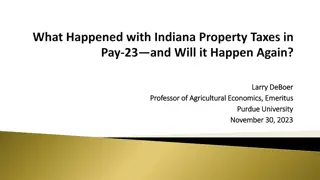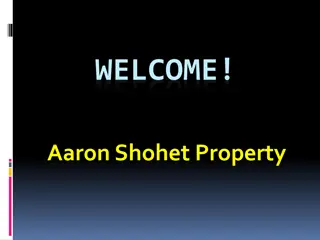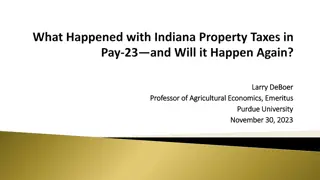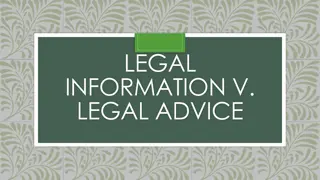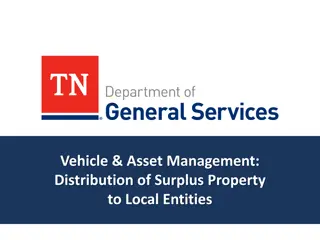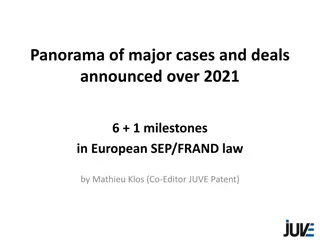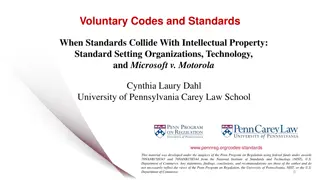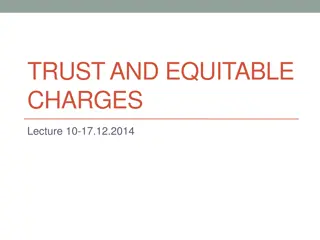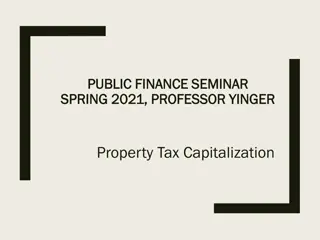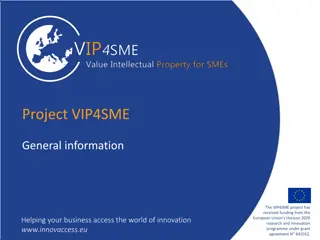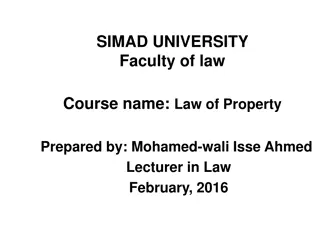FRAND Rules vs Standards in Intellectual Property: A Legal Perspective
Nicolas Petit's presentation at the LCII-TILEC Conference delves into the intricate differences between FRAND rules and standards within the realm of intellectual property law. The discussion covers the implications of these distinctions on SEP policies, the Rule of Law, and various legal theories and court cases. Through illustrations and theories, the presentation explores the nuanced cost-benefit analysis associated with FRAND rules versus standards, shedding light on the complexities inherent in this legal domain.
Download Presentation

Please find below an Image/Link to download the presentation.
The content on the website is provided AS IS for your information and personal use only. It may not be sold, licensed, or shared on other websites without obtaining consent from the author.If you encounter any issues during the download, it is possible that the publisher has removed the file from their server.
You are allowed to download the files provided on this website for personal or commercial use, subject to the condition that they are used lawfully. All files are the property of their respective owners.
The content on the website is provided AS IS for your information and personal use only. It may not be sold, licensed, or shared on other websites without obtaining consent from the author.
E N D
Presentation Transcript
FRAND: RULES V. STANDARDS? Nicolas Petit, University of Liege (ULg) LCII-TILEC Conference Brussels, 29 May 2017
Rules v Standards Law can prohibit: In a standard, the content of the law is specified ex post by the adjudicator In a rule, the content (or some of it) of the law is specified ex ante by a rule-maker driving in excess of 60 mph on expressways driving unreasonably fast www.lcii.eu www.lcii.eu
Relevance to FRAND-pledged SEPs Policy Law No systematic understanding of the costs and benefits of FRAND rules as opposed to standards Scalia: the Rule of Law, the law of rules, be extended as far as the nature of the question allows . O Connor: flaws and dangers of a Grand Unified Theory that may turn out to be neither grand nor unified. Literature Ehrlich and Posner, 1974 Diver, 1983 Kaplow, 1992 US Courts case-law Huawe v ZTE IEEE-SA revised patent policy Courts to use the discretion granted to them under eBay to selectively limit the use of injunctions (Shapiro, 2010) More SSOs should follow the lead of the IEEE by clarifying their patent policies (Shapiro, 2015) www.lcii.eu www.lcii.eu
Outline 1. Theory 2. FRAND rules > FRAND standards: Theory and Evidence 3. Second Best FRAND rules 4. Models of rules www.lcii.eu www.lcii.eu
1. Theory Promulgation cost (PC) Advice cost (AC) Enforcement cost (EC) Rule (R) High (unless as precedent) Low Low Standard (S) Low High High Outcome S R R Average Total Cost of operating rule v standard: (PC+AC+EC)/units of enforcement proceedings Frequent conduct Infrequent conduct Rule Low High Standard High High Kaplow frequency hypothezis: Economies of scale with rules. At given frequency of enforcement proceedings, rules less costly than standards. www.lcii.eu www.lcii.eu
Illustrations FRAND standards FRAND rules Ericsson v D-Link, 3rd Circ. Huawe v ZTE, CJEU (F)RAND terms vary from case to case FRAND create particular circumstances , which justify placing legal constraints on SEP owners [w]e believe unwise to create a new set of Georgia-Pacific like factors for all cases involving RAND encumbered patents. Although we recognize the desire for bright lines rules and the need for district courts to start somewhere, courts must consider the facts of record when instructing the jury and should avoid rote reference to particular damages formula (emphasis added) No abuse, as long as 3 conditions are met IEEE-SA revised patent policy Defines reasonable rates + valuation methodology incl. SSPPU www.lcii.eu www.lcii.eu
2. question FRAND rules >< standards is an empirical Promulgation costs v enforcement costs Promulgation costs: higher with FRAND rules? Informational: divided scholarship Transactional: legislative>private>regulatory agency>judge Enforcement costs: lower with FRAND rules? Less cases Thinner cases Which of those two effects dominates the other is a question of frequency (Kaplow, Ehrlich and Posner) Empirical question Number of US FRAND related suits (Contreras, 2013) Sensationalizing of litigation (Gupta and Snyder, 2014) Avoid optical illusion of large companies and billion $ stakes www.lcii.eu www.lcii.eu
Darts IP FRAND RELATED CASES IN TELECOM INDUSTRY 16 14 12 10 8 6 4 2 0 2009 2010 2011 2012 2013 2014 2015 2016 2017 www.lcii.eu www.lcii.eu
3. Second Best FRAND Rules? Interdependence P-E Numerical Example When P is high, rulemaker settles for second best rule, which does not entirely specify the content of the law Enforcement proceedings burdened by discrete recurring charge on top of the variable cost of adjudication E Which of ex ante P decrease or ex post E increase is higher? Equivalence is not a given: distinct drivers of costs Specific E costs: deference v reliance doctrine? www.lcii.eu www.lcii.eu
4. Models of (FRAND) rules Model of rule influences P and E costs differentials Traditional legal scholarship proposes many angles to address that issue www.lcii.eu www.lcii.eu
Hybrid rules Continuum core of certainty v penumbra of uncertainty (Hart) Approaches : states what factors [...] should be considered in arriving at a conclusion Rules that mix rules and standards 15 Georgia Pacific factors Lower P but possibly higher E due to lack of formal realizability www.lcii.eu www.lcii.eu
Rules of obligation v rules of recognition Primary v secondary rules (Hart) Substantive v formal rules (Kennedy) Dworkin: a parking ordinance of the city of New Haven is valid because it is adopted by a city council, pursuant to the procedures and within the competence specified by the municipal law adopted by the state of Connecticut, in conformity with the procedures and within the competence specified by the constitution of the state of Connecticut, which was in turn adopted consistently with the requirements of the United States Constitution . Fictional FRAND-imposed rate regulation which controls licensing levels CEN-CENELEC position paper on FRAND which proposes to defer to the outcomes generated by a reciprocal FRAND attitudes to licensing negotiations P likely to be high for rule of obligation, E likely to be low P likely to be low for rule of recognition, effect on on E is not clear: May be high when rule is complex (Dworkin example) and low when rule is simple 2-directional effet on E www.lcii.eu www.lcii.eu
Strong v Weak Rules A rule (and standard) has a trigger and a response, and both can be soft or hard (Schlag). A hard rule says: if infringement of a valid patent is found, then injunction shall proceed A weak rule says: if infringement of a valid patent is found, then injunction shall proceed unless the infringer raises a valid equity argument. Crystal v Mud Rules (Reese): exception and equitable second guessing Default rules and gap fillers in contracts Waivers: Posner IEEE-SA revised patent policy, and the practice negative Letter of Assurances ( LoA ) Ex post enforcement remain bound to resolve legal questions (what is FRAND) Ehrlich and Posner: Again, however, some benefits of governance by rules are sacrificed by recognizing exceptions based on implicit use of an overriding standard Weak rules have high P costs, high E costs www.lcii.eu www.lcii.eu
Discovery v Distributional Rules Distributional rules seek to affect reasonable sharing of surplus between parties Distributional rules High P and low E costs Necessity to design a rule that avoids over and under inclusion 25% rule in licensing transactions Discovery rules trust that basic rules of the game will yield reasonable outcomes Close but distinct from primary and secondary rules, because based on Hayekian idea of economically efficient outcomes FRAND dot v FRAND range Physics v Biology Risks of antitrust liability Discovery rules Orange Book Standard Huawe v ZTE Low P cost, 2-directional effect on E cost? www.lcii.eu www.lcii.eu
Conclusions At a very high level, not a given that FRAND rules are superior to FRAND standards: empirical question that demands verification (frequency) Due to interdependence of P and E, second best rules may also be very costly and Kaplow s frequency hypothesis may not hold Discovery and negotiation rules > distributional and obligation rules More to follow in working paper 1. 2. 3. 4. www.lcii.eu www.lcii.eu
References Kaplow, Louis. Rules versus standards: An economic analysis. Duke Law Journal (1992): 557- 629. Ehrlich, Isaac, and Richard A. Posner. "An economic analysis of legal rulemaking." The Journal of Legal Studies 3, no. 1 (1974): 257-286. Diver, Colin S. "The optimal precision of administrative rules." The Yale Law Journal 93, no. 1 (1983): 65-109. www.lcii.eu www.lcii.eu




